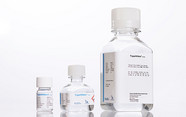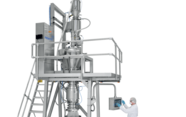Can AI Help Solve the Solubility Challenge?
We explore how AI-based tools are making a mark in formulation by improving solubility
| 10 min read | Hot Topic

Every year, The Medicine Maker celebrates new drug development and manufacturing technologies through our Innovation Awards. In 2024, our winner was mPredict Co-Crystal Prediction Service from Merck KGaA, Darmstadt, Germany. The service uses AI to predict optimal co-formers for an API. The result? Co-crystals with improved solubility and stability.
Here, we speak with Daniel Price, Head of Excipients Business at the company, to find out more about pharma’s solubility problem – and how the company came up with an AI-based approach.
The pharma industry has been talking about a solubility problem for years. Why are so many drugs in pipelines poorly soluble and what are the challenges of developing new solutions to address solubility problems?
Daniel Price: With 70–90 percent of drugs currently under development being poorly soluble, addressing solubility challenges has never been more important.
Sophisticated drug discovery tools are being used to identify potential candidates to address the unmet needs of patients and treat rare/orphan diseases. These highly efficient tools – such as high-throughput screening and target-oriented drug discovery – can rapidly help medicinal chemists to identify and test a large number of promising drug candidates, but many of the identified candidates are complex chemical compounds that are hard to formulate and show poor solubility. In general, the size and molecular weight of APIs is also increasing, which further leads to poor aqueous solubility and poor permeability.
Solubility is critical as the drug must be soluble in the gastrointestinal fluids to pass through the intestinal membrane and into systemic circulation, where it can be delivered to the site of biological action. There are several chemical and formulation approaches to enhance solubility and dissolution of a drug depending on their subclass, but with several root causes and many potential solutions, selecting the best is often time consuming. Additionally, there is no one size fits all approach, and time and resource pressures in pharmaceutical development may mean that the best solution is not always found.
It was this combination of criticality and complexity that led us to begin exploring AI solutions for formulation screening of poorly soluble molecules.
Why is co-crystallization seen as a promising solubility-enhancing approach?
DP: Co-crystallization is a relatively new chemical approach to enhance drug solubility, where an API is combined with a pharmaceutically acceptable co-former in a co-crystal structure. The resulting co-crystals have unique properties that can address challenges related to drug manufacturability, solubility, stability, and bioavailability – often resulting in significantly higher solubilities than the original API, without altering the chemical identity or reducing its biological activity. Additionally, co-crystallization is useful for substances without an ionizable functional group – as opposed to salt formation. Finally, co-crystallization within drug substance manufacturing is a simpler process compared to other solubility-enhancing technologies, such as enabling formulations.
In addition to the process and performance benefits of co-crystals, this strategy may also be used to extend the life cycle of an API, or even to bring generic versions of an API to market faster.
What role does the co-former play and why is selection so challenging?
DP: The co-former interacts nonionically with the API to form a co-crystal via a solid-state bond. The co-former must be structurally compatible with and have a similar solubility to the API in various solvents. Therefore, co-former selection is dependent on API purity, structural features and physical properties. This diversity in the key success factors of drug-co-former interaction is what makes development of co-crystals so challenging, time consuming and expensive.
Several experimental screening techniques can be used for co-crystal formation, such as solvent crystallization, solvent assisted grinding, sublimation, slurrying and hot melt extrusion (DSC screening), but a scientist must identify which technique is most suitable.
Secondly, comprehensive experimental screening is rarely possible due to limited API availability, and lack of resources and time needed to conduct extensive experiments. It’s also common that scientists will use co-former chemicals they are most familiar with, which limits the different co-crystal combinations they can generate. Although there are some guidelines to help guide co-former choice, these are somewhat rudimentary and limited to a smaller set of possible combinations. A much broader toolbox of potential co-formers could be explored if there was a more efficient and quick process for large-scale screening, avoiding the need for expensive and time-consuming experiments.
Tell me about the story behind the mPredict Co-Crystal Prediction Service; why was this area important to the company and how did you go about developing the AI tool for this service?
DP: We have a strong background supporting our customers during drug development with a technically differentiated portfolio of excipients and raw materials for drug substance and drug product manufacturing. We have an innovation-driven culture and mindset and center our product and technology development on tackling the most difficult challenges in pharmaceutical development.
Hand-in-hand with this culture, we keep our finger on the pulse of new technology developments, emerging trends and new ideas. With AI now being such an important part of our daily lives and, increasingly, in drug discovery, we started with an ambition to bring drug formulation closer to digital technologies and AI. Given our extensive background in solubility, we applied various methodologies to several key challenges: co-crystallization prediction is one of our first success stories, but there are many more on the horizon!
To get more specific about co-crystallization, what we have developed is a new algorithm that combines computational chemistry, machine learning, and big data to calculate the likelihood of a successful co-crystal interaction between an API and co-former. We learned a lot during this process; for example, never underestimate the importance of data quality! After several failed attempts at mining literature data to build our model, we pivoted to developing all our data from scratch internally. This was a key learning, which we now apply to all our AI models under development and has significantly improved the reliability and predictability of our calculations. Additionally, our service delivers results 96 percent faster than traditional experimental screening.
Our Co-Crystal Prediction Service, a fantastic addition to the SAFC portfolio, is now live and being used to accurately and reliably predict the best co-crystal co-formers for a range of diverse and structurally interesting molecules – without the need for any prior experiments!
How accurate are the results and are there any success stories you can share?
DP: During an extensive assessment of our model’s prediction, we performed three independent validations using a “test dataset,” which always contained different APIs from the training dataset. We initiated a comparison with current industry standard, alternative solutions and performed beta trials. The results were really encouraging. mPredict performed two times better than industry standard models, and our statistical analysis of the results shows an accuracy of 88 percent in the prediction of successful co-crystals.
These findings were supported in the results of our beta trials, where in one calculation, six out of seven predicted co-crystals were validated experimentally to form co-crystals with the test molecule – some of which had never been reported before in the scientific literature! This last point really underlines the potential in using AI for identifying new opportunities for product lifecycle extension.
What trends have you seen in the types of APIs that benefit most from co-crystallization?
DP: Poorly water-soluble APIs without ionic functional groups, which have limited options for salt formation, are perfect candidates that could benefit from co-crystallization. Furthermore, co-crystallization may show improvement and better control over physical and chemical stability by minimizing polymorphism. The potential for co-crystallization as a product lifecycle expansion strategy really expands the potential of this approach to almost all small molecule drugs.
However, what we’re seeing is that it’s not only customers in large innovator pharmaceutical companies who are interested in this tool, but also smaller companies who cannot do extensive co-crystallization experiments, as well as companies producing generic drugs (non-branded medicines) who want to improve the formulation of an existing product and overcome intellectual property challenges.
How do you think AI technologies will continue to improve and how will this shape the future of formulation?
DP: We have seen broad adoption of AI in the drug discovery space, and within our organization we already have two solutions that support this. Our AIDDISON drug discovery software taps into the power of AI, machine learning, and CADD methods – providing a one-stop shop for AI-generative methods, virtual screening of large chemical spaces, and tools for hit-to-lead discovery and optimization. The software allows researchers to explore unbounded chemical space and generate ideas for entirely new compounds.
We also have our SYNTHIA retrosynthesis software, which is powered by sophisticated algorithms that can help experts access and make use of the vast amounts of data on chemical synthesis collated over decades of research which predicts whether it will be possible to make the compound through chemical synthesis.
However, in drug development generally, adoption of AI has been on a slower path. But with increasing pressure on pharmaceutical companies to reduce cost and time to market, the use of AI in formulation development has tremendous potential. It will not only help shorten time to market and bring new medicines to patients faster, but will also allow pharma companies to broaden their investigations to a wider range of chemicals and solutions by trying out things that go beyond the obvious
Catching Up With Sebastian Arana, Head of Process Solutions
How have your customers reacted to the launch of the service?
SA: Very positively. At Process Solutions, we have a customer-centric culture that focuses on anticipating and shaping the future of pharma together with our customers as they develop, make, purify, formulate and assure the quality of their life-enhancing and life-saving drugs.
Our innovation is driven by their needs to problem solve – in the case of mPredict delivering results 96 percent faster than traditional experimental screening.
We have received a fantastic response from our customers after the launch of mPredict, and already have many active projects with a variety of molecules and needs.
Do you have any further plans to implement AI into your products and services?
SA: As solutions providers, we facilitate the transition to digitally connected operations by offering innovative solutions that enhance operational efficiency, productivity, flexibility, data management, and compliance. At the Life Science business of Merck KGaA, Darmstadt, Germany, we are dedicated to delivering solutions that assist our partners achieving their goals of automated, data-driven and digitally connected operations.
Digital and AI are at the core of our product and development roadmap. In the API processing space specifically, the mPredict co-crystal service is a key success story. In parallel, our expert team has been working on several additional use cases in the drug formulation space, such as similar models to predict optimal polymer selection in amorphous solid dispersion technologies. We are also developing a digital platform to support parenteral formulation development, buffer selection, and cell culture media optimization.
We are committed to delivering solutions in a stepwise manner, ensuring that we effectively meet the present needs and future ambitions of our customers, recognizing that each partner’s ambitions are unique.
Thoughts on the future?
SA: The future looks very bright for the use of AI and digital in pharmaceutical development, especially as this will directly benefit patients waiting for new therapeutics. We take our role in this transformation very seriously and will continue to provide cutting-edge products and technologies to solve the toughest challenges in drug development. mPredict is our first step on the digitally enabled formulation journey, and we are very excited for what’s coming on the horizon!



















